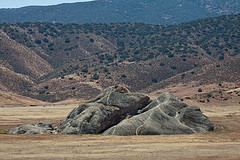Eliminating the “White Space” from Conservation Planning
By: Amos S. Eno
Posted on:08/10/2010A decades-long state director for the Bureau of Land Management makes a case for private lands as critical conservation corridors.
Ed Hastey has a long and distinguished career working in natural areas management: more than 40 years with the BLM, including 21 years as California State Director, and an additional 11 years in conservation consulting.
Ed has worked the past 11 years with the Resources Legacy Fund helping to implement large-scale conservation campaigns in California. Given his experience working with federal, state, and private entities, Ed can provide one of the most authoritative perspectives on the value of private land conservation in the country.

I first met Ed in the 1980s, through my interaction with California organizations on behalf of the National Fish and Wildlife Foundation (NFWF). He is one of the federal professionals I’ve most admired, for many things, but most of all his pure common sense. In 1997, Ed received NFWF’s Chuck Yeager award for his willingness to partner with other organizations to achieve stewardship results both on and off public lands.
Private Lands are Not “White Space”
Ed tells me that “federal agencies tend not to recognize the value of private land conservation as much as public lands, in part because they tend to acquire fee title. In fact, it’s still a problem I see, particularly in the overall planning process. Agencies always plan within their boundaries,” but not outside them.
One reason for this, according to Ed, is that “there’s a lack of inventory of easements on private lands, so they are easy to ignore.” Agencies and others don’t care about private land status because they don’t see it.
For example, Ed says, “I went to look at a Forest Service plan in southern California a few years ago. Everything outside the plan was white! Adjoining lands are critical in California and other areas in the Southwest. In the last 10 years, we’ve made a lot of effort at the Foundation to look at corridors and connectivity. They are so important. Without that connection, if there is climate change, and no connectivity, wildlife will be stuck. The only answer is to allow animals to move along elevational and latitudinal gradients. This is where private lands really play a key role.”
Private Land Corridors
Private land can provide great corridors, particularly in the West, where so much private land is located in the lowland riparian zones. These areas are both critical to wild species and also make natural corridors for dispersal of both plants and animals.

Ed says that the Tejon Ranch is a good example of a private lands corridor. The Foundation is working on protecting the 240,000-acre Tejon Ranch, along with a couple more properties, to connect to the Sequoia National forest in the Sierras with southern California coastal ranges. The Tejon corridor itself harbors conifers, oak woodlands, grasslands, and Joshua trees that support California condor, San Joaquin kit fox, blunt-nosed leopard lizard and other rare or declining species.
Ed cites three reasons that private lands are essential to connect existing protected areas:
- “because you can’t get fee title to some of these areas;”
- “because the dollars are not there for acquisition,” and
- “because even if the dollars were there, then the stewardship would be lacking.” This is because federal and state budgets are stretched to the breaking point, and public agencies often can’t manage the properties they do have.
“Agencies are under a lot of pressure in terms of what’s going on in their own lands. On the other hand, private lands that are protected from development usually come with their own stewardship.” Coming from the former director of an agency that manages 15.2 million acres of public land in California, this statement should not be taken lightly.
“Even a rancher not doing the greatest job managing the land is helluva lot better than having that land carved up into subdivisions.” I couldn’t agree more and have said so myself numerous times.
For all these reasons, Ed argues, private lands are critical, and it’s one reason easements are so popular. “The California Rangeland Trust, through private conservation easements, has really connected areas that would otherwise never have been looked at. The state Wildlife Conservation Board has also been active and has helped a lot.”
For those of you who may be thinking that the sluggish economy means subdivisions are no longer as much of a threat to conservation, please check this blog next week. Ed Hastey has an answer for you!
 Sign In
Sign In
 Sign In
Sign In
